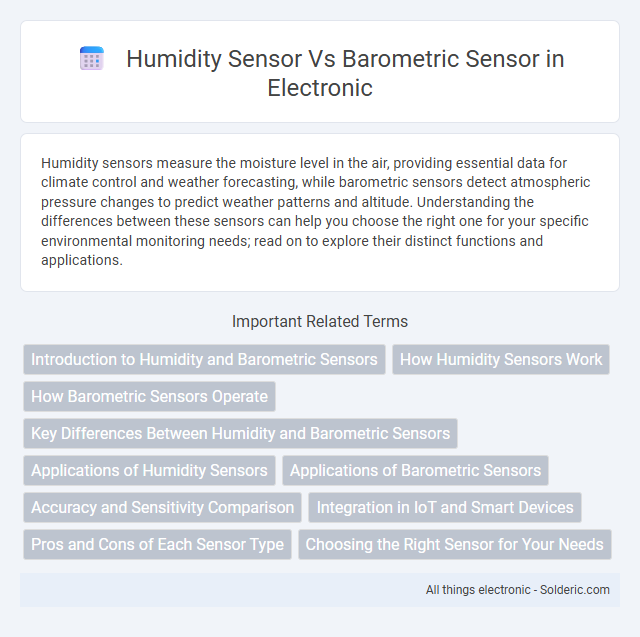Humidity sensors measure the moisture level in the air, providing essential data for climate control and weather forecasting, while barometric sensors detect atmospheric pressure changes to predict weather patterns and altitude. Understanding the differences between these sensors can help you choose the right one for your specific environmental monitoring needs; read on to explore their distinct functions and applications.
Comparison Table
| Feature | Humidity Sensor | Barometric Sensor |
|---|---|---|
| Primary Measurement | Relative Humidity (%) | Atmospheric Pressure (hPa or Pa) |
| Typical Use | Climate control, HVAC, weather monitoring | Altitude detection, weather forecasting |
| Measurement Principle | Capacitive, resistive, or thermal conductivity | MEMS piezoresistive or capacitive sensing |
| Accuracy | +-1 to 3% RH | +-0.1 to 1 hPa |
| Output | Analog or digital humidity values | Analog or digital pressure readings |
| Common Applications | Indoor air quality, agriculture, industrial monitoring | Weather stations, altimeters, drones |
| Environmental Dependency | Directly affected by moisture content | Measures atmospheric pressure regardless of humidity |
Introduction to Humidity and Barometric Sensors
Humidity sensors measure the moisture level in the air, providing critical data for climate control, weather forecasting, and industrial processes. Barometric sensors detect atmospheric pressure changes, essential for altitude measurement, weather prediction, and aviation safety. Both sensors are integral in environmental monitoring systems, offering complementary information about air conditions.
How Humidity Sensors Work
Humidity sensors measure the moisture level in the air by detecting changes in electrical capacitance or resistance caused by water vapor absorption. These sensors often use materials like polymer films or ceramics that react to humidity fluctuations, converting this data into an electrical signal for accurate monitoring. Your environment's humidity control depends on these precise readings to maintain comfort and prevent damage.
How Barometric Sensors Operate
Barometric sensors measure atmospheric pressure using a sealed chamber and a pressure-sensitive element, such as a piezoelectric or capacitive sensor, which deflects in response to air pressure changes. This deflection causes a measurable electrical signal proportional to the ambient pressure. These sensors provide critical data for weather forecasting, altitude measurement, and environmental monitoring by accurately detecting pressure variations.
Key Differences Between Humidity and Barometric Sensors
Humidity sensors measure the moisture level in the air, expressed as relative humidity, while barometric sensors detect atmospheric pressure changes crucial for weather forecasting and altitude determination. Unlike humidity sensors that rely on capacitive or resistive elements, barometric sensors use piezoelectric or capacitive pressure transducers. Understanding these key differences helps you select the right sensor for applications requiring precise environmental monitoring.
Applications of Humidity Sensors
Humidity sensors are essential in HVAC systems for maintaining optimal indoor air quality and comfort by monitoring moisture levels. These sensors are widely used in agriculture to ensure precise irrigation and protect crops from fungal diseases caused by excess humidity. Your smart home devices benefit from humidity sensors by regulating air moisture, preventing mold growth, and enhancing overall living conditions.
Applications of Barometric Sensors
Barometric sensors are widely used in applications requiring precise atmospheric pressure measurement, such as weather forecasting, altitude determination in aviation and hiking, and indoor air pressure monitoring for HVAC systems. These sensors enable smartphones and GPS devices to provide accurate elevation data, improving navigation and fitness tracking. Your devices rely on barometric sensors to optimize performance in environments where pressure changes affect functionality.
Accuracy and Sensitivity Comparison
Humidity sensors measure atmospheric moisture with high sensitivity, often detecting changes as small as 1% relative humidity, making them ideal for environments requiring precise moisture control. Barometric sensors, designed to measure atmospheric pressure, offer exceptional accuracy within a narrow pressure range, typically around +-0.1 hPa, critical for weather forecasting and altitude detection. When choosing between the two, your application's need for exact moisture levels or pressure readings determines which sensor provides the best accuracy and sensitivity.
Integration in IoT and Smart Devices
Humidity sensors measure moisture levels in the environment, providing critical data for climate control and agricultural IoT applications, while barometric sensors detect atmospheric pressure, enabling weather prediction and altitude tracking in smart devices. Integration of humidity sensors enhances smart thermostats and environmental monitoring systems by optimizing comfort and energy efficiency. Barometric sensors improve navigation accuracy and weather responsiveness in wearables and connected drones, supporting robust IoT ecosystems.
Pros and Cons of Each Sensor Type
Humidity sensors offer precise measurement of moisture levels essential for climate control and agricultural applications, but they may suffer from slower response times and sensitivity to contaminants. Barometric sensors provide accurate atmospheric pressure data crucial for weather forecasting and altitude determination, though they can be affected by temperature fluctuations and require regular calibration for long-term accuracy. Choosing between the two depends on the specific environmental parameters needed, balancing sensitivity, response time, and maintenance requirements.
Choosing the Right Sensor for Your Needs
Humidity sensors and barometric sensors serve distinct purposes and selecting the right one depends on the specific application requirements. Humidity sensors measure moisture levels in the air, crucial for HVAC systems, agricultural monitoring, and weather forecasting, while barometric sensors detect atmospheric pressure, essential for altitude measurement, weather prediction, and aircraft instrumentation. Understanding the target environment and data needed ensures optimal sensor performance and accurate readings tailored to humidity or pressure monitoring needs.
humidity sensor vs barometric sensor Infographic

 solderic.com
solderic.com